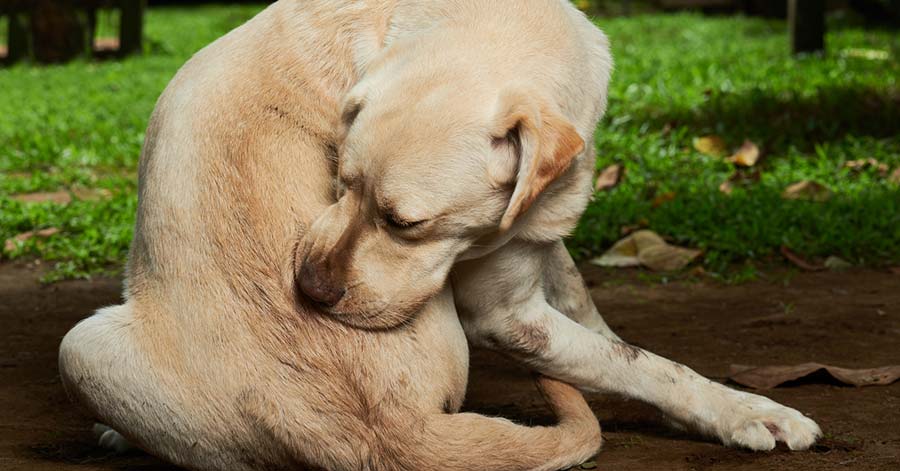The Best (and Safest)
Flea Treatment for Dogs

Fleas can be annoying to say the least. A flea infestation can be hazardous to both human and dog health, but chemical flea products are dangerous for both of you. Here is the rundown on what you can do to naturally prevent a flea infestation on your dog.
EPA Study Warns About Commercial Flea Treatment Dangers
Don’t be fooled. Labels may not give you all the facts about what you are putting on your dog to get rid of fleas.1 In fact, the dangers of commercial flea liquids, collars, powders, pills, and sprays were the focus of an in-depth investigation by the United States Environmental Protection Agency (EPA) in 2009. It was in response to over 44,000 “adverse reaction” complaints to on-spot flea control products in 2008 alone.2
One harmful ingredient found in commercial products is Imidacloprid. Over 400 products use it, including many flea control products. Adverse reactions for both humans and animals include rash, vomiting, dizziness, confusion, drooling (in animals), tremors, fatigue, and seizure.
The U.S. EPA maintains that there is no connection between imidacloprid and cancer. In November 2017, however, the National Resources Defense Council (NRDC) recommended that the “EPA should re-do its cancer assessment of imidacloprid,” citing a possible link to some cancers.3 According to the National Pesticide Information Center, studies have also found that exposure caused reproductive issues in pregnant laboratory rats.4
In 2010, the EPA released their own recommendations.5 A major one was that flea and tick companies be required to put ingredient information on their product labels.6 If you decide to use commercial flea products for your dog, be sure to do your homework. One great resource is the nonprofit consumer organization, the Environmental Working Group.7
Understanding the Flea Life Cycle
Knowing a little about the flea lifecycle can help you naturally prevent infestation from affecting your pet and home.8 There are hundreds of species of fleas but all of them share a favorite food: mammalian blood. Here is another thing to consider. Fleas go through four main stages: egg, larvae, pupa, and adult. The total life cycle of a typical flea can range from a couple of weeks to several months, depending on their environment. Warmer climates tend to shorten the life cycle, which is why infestations often happen in the summer. What’s more, a female flea can lay up to 50 eggs a day!9
While these are not appealing thoughts, they are important factoids to consider when putting together a sound, safe flea prevention or treatment protocol for your pet.
Watch FREE Wednesday, April 4, 2018
Enter your name & email below to register to watch all 7 episodes FREE!
3 Steps to Being “Flea Free”
Unfortunately, your natural flea plan cannot be completed by doing something once and calling it good. Those who have the most success stamping out fleas instigate a multi-pronged, ongoing approach.
STEP #1: Make your pet an unwelcome place for pests.
Fleas are anatomically designed to burrow themselves in animal fur, making your best friend a flea’s favorite hide out and lunch spot. The first step in cutting the flea current is to get rid of those fleas that have already set up shop.
If your pooch has a severe infestation, get him into the tub right away. Believe it or not, a simple shampoo of equal parts biodegradable dish soap and vinegar added to 4 parts water will kill adult fleas almost instantly.
After shampooing, be sure to comb your dog thoroughly with a fine-toothed flea comb. Have a bowl of sudsy water handy so you can dip the comb in it between swipes.
STEP #2: Use a natural flea treatment for your home and yard.
Clean, clean, clean your floor and pet bedding at least once a week. Vacuum your carpet often, as well as between couch cushions. Toxicologists at Cornell University College of Veterinary Medicine recommend daily cleaning for intense infestations.10
In addition, you can also sprinkle diatomaceous earth11 or borax on carpets. Both of these substances are non-toxic to humans and animals, but should not be inhaled. Be sure that no one (including your pet) is around when you sprinkle the powder and wear protective gloves and a mask. The powder should sit for several hours before vacuuming. Use diatomaceous earth that is intended for garden or home, not the chemically-treated varieties meant for swimming pools.
Finally, consider “nematodes” in your yard. These are microorganisms that love to feed on flea larvae. They can be sprayed on landscaped areas and lawns and are totally safe for animals and humans.12 If nematodes are not available, try garlic. Fleas hate it, so planting it around you home or spraying “garlic water” (garlic boiled in water and steeped for several hours) can be effective as well. Go light with the spray, however, since too much garlic can sometimes harm beneficial bugs.
STEP #3: Keep it going!
Especially during hot, humid weather, you will want to add natural flea control techniques to your weekly routine. In addition, there are actions you can take every day.
When a dog’s immune system is strong, they will be less likely to succumb to conditions such as Flea Allergy Dermatitis (FAD). Stay away from cheap commercial dogfoods that may contain infection-laden animal parts and moldy grains. B vitamins can ensure a shiny, flea resistant coat. Coconut oil is also an anti-bacterial that can be mixed directly in with food (and most dogs love the taste).
Black walnut has been a traditional flea repellant for centuries13 but be sure to consult with a holistic vet since too much can be toxic. Also keep in mind that digestive health is directly related to skin health. Your dog needs digestive enzymes and probiotics just as much as you do.
Finally, you can make a natural yet effective spritz for daily application. There are dozens of natural dog flea repellent recipes out there. The easiest is vinegar and water or a few drops of lemon essential oil and water. Add to a spray bottle, shake, and spray! (Avoiding your dog’s eyes, ears, and other sensitive areas, of course.)
There are Many Options for Natural Flea Treatment
Even though the EPA and the USDA now regulate pet flea control products, the truth remains that many pesticides included in these products have not been tested for safety or have been linked to diseases such as cancer in both humans and animals.
You do have natural options. Going natural when it comes to flea control keeps you and your furry canine friend flea free and safe!
- https://www.magazine-advertisements.com/uploads/2/1/8/4/21844100/hartz-flea-killing-collar-1.jpg
- http://news.vin.com/VINNews.aspx?articleId=15367
- https://www.nrdc.org/experts/jennifer-sass/nrdc-epa-red-flags-imidacloprid-health-risks
- http://npic.orst.edu/factsheets/imidagen.html
- https://www.epa.gov/pets/epa-evaluation-pet-spot-products-analysis-and-plans-reducing-harmful-effects
- https://www.consumeraffairs.com/flea-and-tick-product-risks-and-recalls
- https://www.ewg.org/news/news-releases/2012/05/31/duke-study-confirms-toxicity-widely-used-pesticide-ingredient#.WqALS5PwbOR
- https://www.thespruce.com/how-to-get-rid-of-fleas-3385668
- https://www.thespruce.com/the-life-cycle-of-the-flea-3384211
- https://www.nrdc.org/stories/nontoxic-ways-protect-your-pet
- https://books.google.ca/books/about/Biological_and_Biotechnological_Control.html?id=9tJe6eBdOFAC&redir_esc=y
- https://www.peta.org/issues/companion-animal-issues/companion-animals-factsheets/flea-control-safe-solutions/
- https://link.springer.com/chapter/10.1007%2F978-3-540-34541-1_6

